Pad Thai with Shrimp
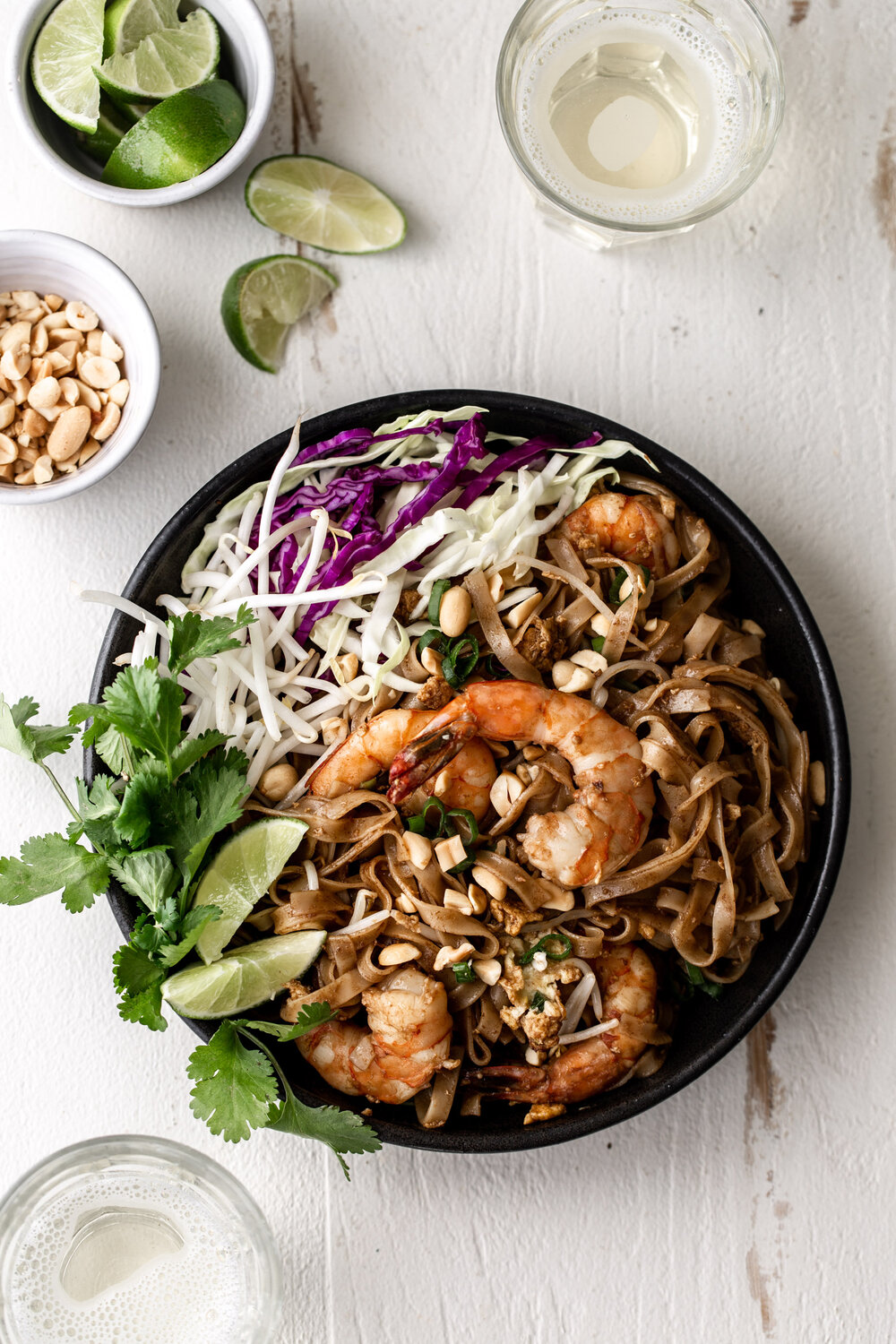
jump toRECIPE
Thai food wonderfully combines salty, sweet spicy and savory flavors. Pad Thai is considered a good introduction into Thai food because of its simplicity as a stir fried noodle dish. Pad Thai (also known as Phat Thai) is one of the most well known Thai dishes, but it is a little known fact that it probably has its roots in China. While there is argument over its origin, it’s now served on just about every Thai menu in the United States and around the world.
While I make this recipe with shrimp you can easily substitute it with thinly sliced chicken breasts or tofu.
Pad Thai with Shrimp
Table of contents

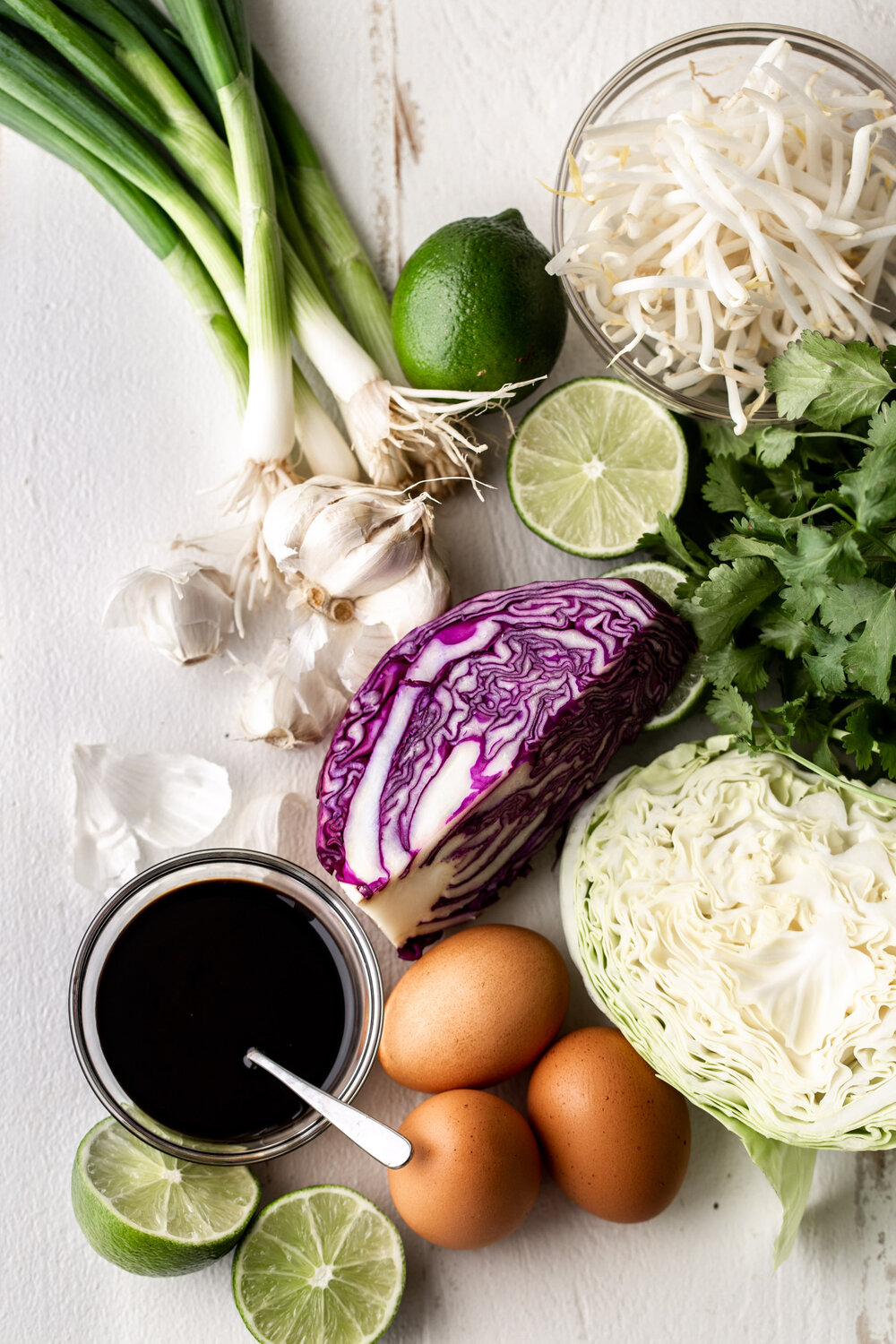
What is Pad Thai?
It’s a delicious noodle dish similar to a stir-fry with flat rice noodles coated in a sweet and sour sauce and served with shrimp (or tofu or chicken) as well as bean sprouts and peanuts. Pad Thai comes together quickly for a crowd-pleasing Thai recipe.
What Kind of Noodles are Used in Pad Thai?
5mm thick rice noodles are typically used in this dish and can be found in the Asian section of most grocery stores and supermarkets. These “pad thai noodles” are soaked in hot water until tender then drained.
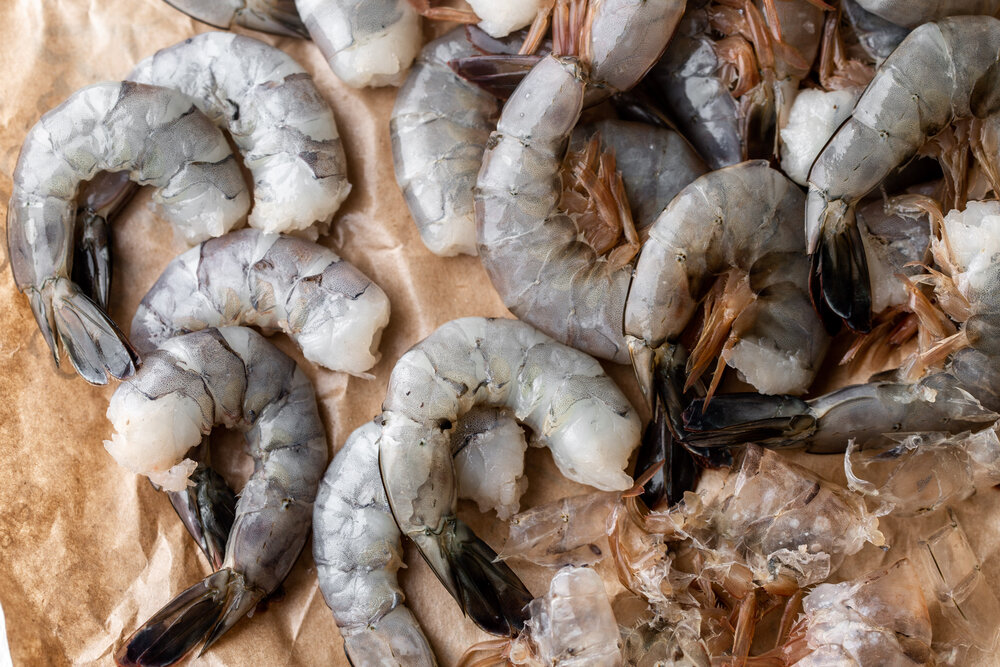
How to Eat Pad Thai
Most Thai food is actually eaten with a fork and not chopsticks. When I was in Thailand I was immediately surprised by the lack of chopsticks at the restaurants. Thai culture adopted Western utensils but with a twist; the fork is typically held in the left hand and a spoon in the right so that the fork can be used to push food onto the spoon to eat. It took some getting used to but I got the hang of it by the end of the trip.

Key Ingredients in This Recipe
- Tamarind paste – Tamarind is a tree that produces a pod-like fruit that tastes similar to lime but with more sweet and tart flavor. Tamarind paste can be found at specialty grocery stores and most Whole Foods in the Asian foods section.
- Fish sauce – Fish sauce gets its signature funky flavor from fermenting fish over a long period of time.
- Shrimp – The terms “jumbo” and “extra jumbo” and “colossal” aren’t standardized terms within the industry. Instead look at the numbers – they estimate approximately how many shrimp are in 1 pound. In this shrimp pad Thai recipe I use shrimp with 21 – 30 per pound. While leaving the tail on is great for aesthetics the tails can also be removed prior to serving for easier eating.
- Mung bean – Mung bean sprouts add texture to the pad Thai recipe. Look for them fresh in bags in produce sections of grocery stores or canned in the Asian section of markets.
- Cabbage – Shredded cabbage also adds texture while also lightening up the noodle dish. A combination of purple and green cabbage adds a contrast of color though either can be used.
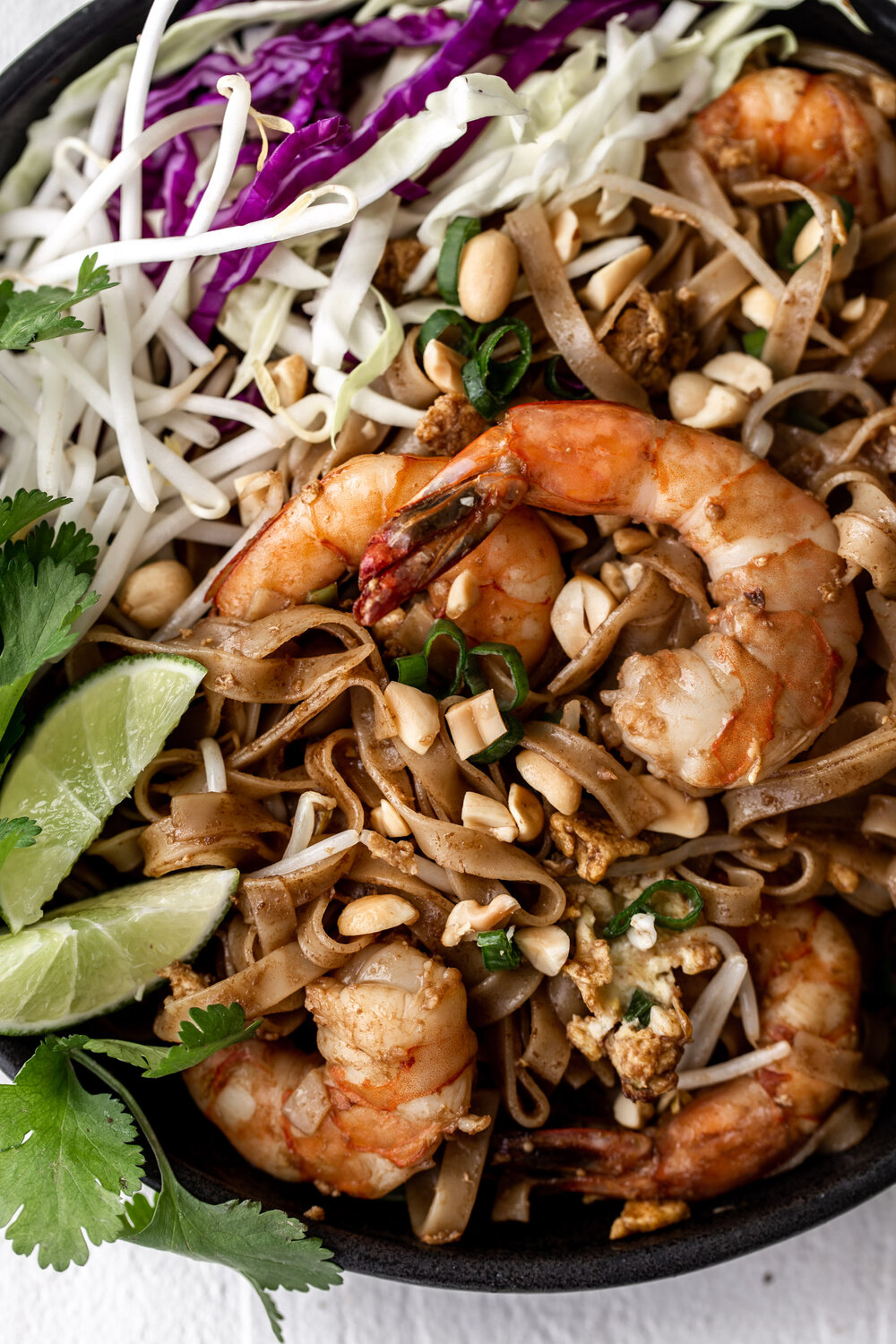
How to Make Pad Thai with Shrimp
For the pad Thai:
- Soften rice noodles. Place the rice noodles in a large bowl filled with hot water and let soak until tender but not mushy, about 5 to 10 minutes. Drain and set aside.
- Make the sauce. In a small saucepan over medium heat, whisk together tamarind paste, fish sauce, honey, rice vinegar, sugar and 2 tablespoons of water. Bring the mixture to a simmer and let cook for 5 minutes. Remove from heat and set aside.
- Sauté aromatics. Heat a wok over high heat, add the oil and heat through. Add the white from the green onions and the garlic, stirring until fragrant, about 30 seconds.
- Cook the eggs. Crack the eggs into the wok and scramble the eggs until they are just set, about 1 minute. Add the shrimp and sauté until just cooked through, about 3 minutes.
- Stir fry the noodles. Add the noodles to the wok along with the sauce. Toss to combine and continue to let cook until the liquid is absorbed, about an additional 3 minutes. Remove from heat and stir in the remaining green onions and the bean sprouts.
For serving:
- Assemble and serve. Serve the pad Thai topped with the peanuts, cilantro and green onions with the cabbage and lime wedges on the side.
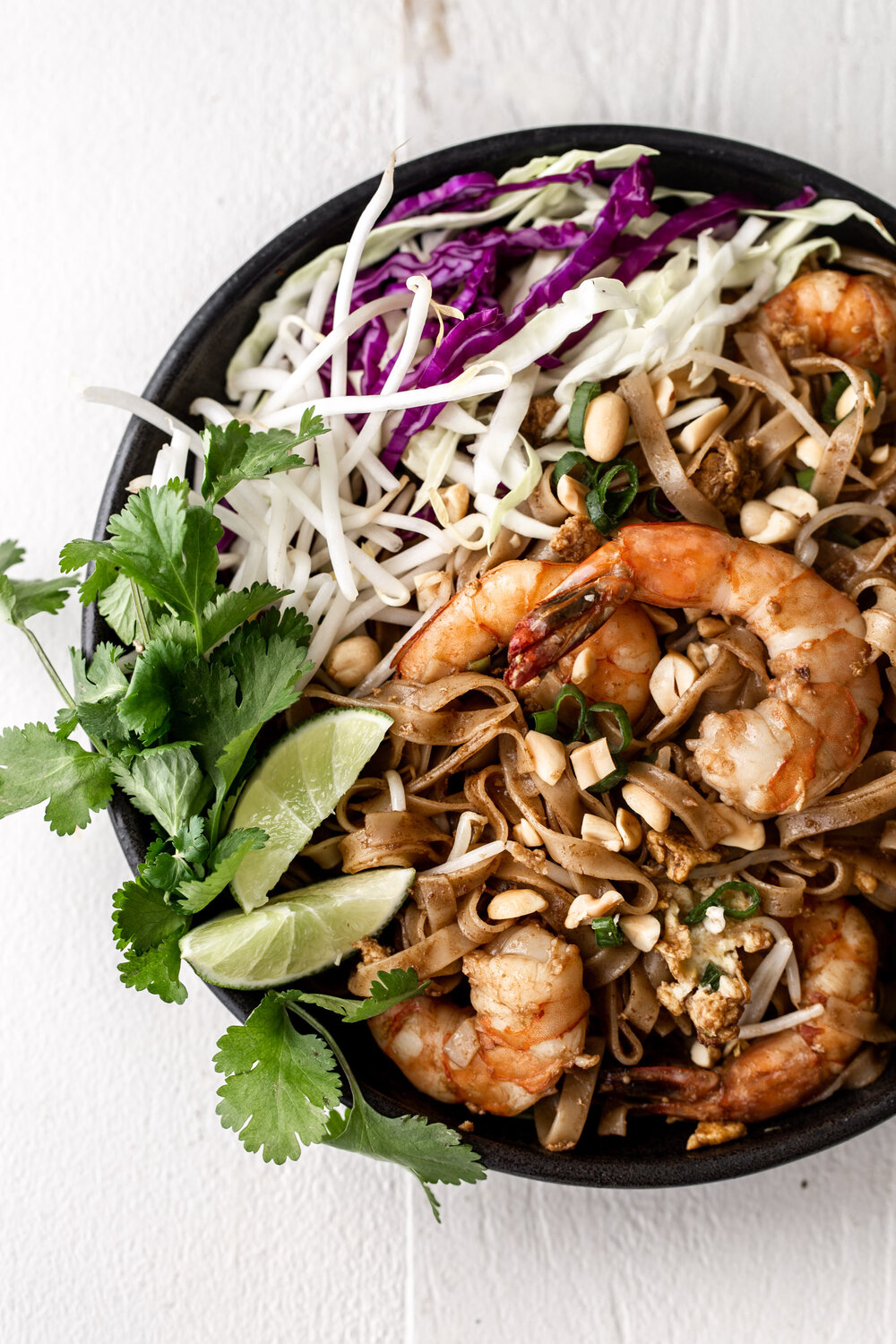
Tips and Tricks for This Recipe
Dietary Restrictions
Because pad Thai is made with rice noodles, the recipe is gluten-free and dairy-free. The recipe can easily be made vegetarian by omitting the shrimp or swapping for tofu.
Cooking rice noodles
I recommend getting the correct noodles for this dish. In most pad Thai the rice noodles are soaked not boiled though some package instructions may vary. The key is to soak the rice noodles so they are tender and al dente but not soggy.
Substitutions/ Swaps
- If you can’t find tamarind paste I recommend substituting with pomegranate molasses (it has a similar texture and flavor) or freshly squeezed lime juice, though this will not have the same texture.
- You can also substitute the tamarind paste with equal parts vinegar and sugar stirred together until the sugar has dissolved.
- Vegetable oil can be substituted for another neutral oil like peanut oil or canola oil in this recipe.
Other Recipes to Try
If you enjoy this pad Thai with shrimp recipe, I recommend checking out some of these other Thai dishes:
Pad Thai with Shrimp
Ingredients:
For the pad Thai:
- 8 ounces pad Thai rice noodles
- 2 tablespoons tamarind paste*
- 2 tablespoons fish sauce
- 2 tablespoons honey
- 1 tablespoon rice vinegar
- 1 tablespoon granulated sugar
- 3 tablespoons vegetable oil
- 4 green onions, thinly sliced, greens and whites divided
- 3 cloves garlic, chopped
- 3 eggs
- ¾ pound (21/30) peeled and deveined shrimp
- 1 cup mung bean sprouts
For serving:
- ½ cup chopped cilantro
- ½ cup chopped dry-roasted peanuts
- 3 cups shredded cabbage
- Lime wedges
Instructions:
For the pad Thai:
- Place the rice noodles in a large bowl filled with hot water and let soak until tender but not mushy, about 5 to 10 minutes. Drain and set aside.
- In a small saucepan over medium heat, whisk together tamarind paste, fish sauce, honey, rice vinegar, sugar and 2 tablespoons of water. Bring the mixture to a simmer and let cook for 5 minutes. Remove from heat and set aside.
- Heat a wok over high heat, add the oil and heat through. Add the white from the green onions and the garlic, stirring until fragrant, about 30 seconds.
- Crack the eggs into the wok and scramble the eggs until they are just set, about 1 minute. Add the shrimp and sauté until just cooked through, about 3 minutes.
- Add the noodles to the wok along with the sauce. Toss to combine and continue to let cook until the liquid is absorbed, about an additional 3 minutes. Remove from heat and stir in the remaining green onions and the bean sprouts.
For serving:
- Serve the pad Thai topped with the peanuts, cilantro and green onions with the cabbage and lime wedges on the side.
DID YOU MAKE THIS?
TAG ME ON INSTAGRAM TO BE FEATURED ON MY STORIES! @cookingwithcocktailrings

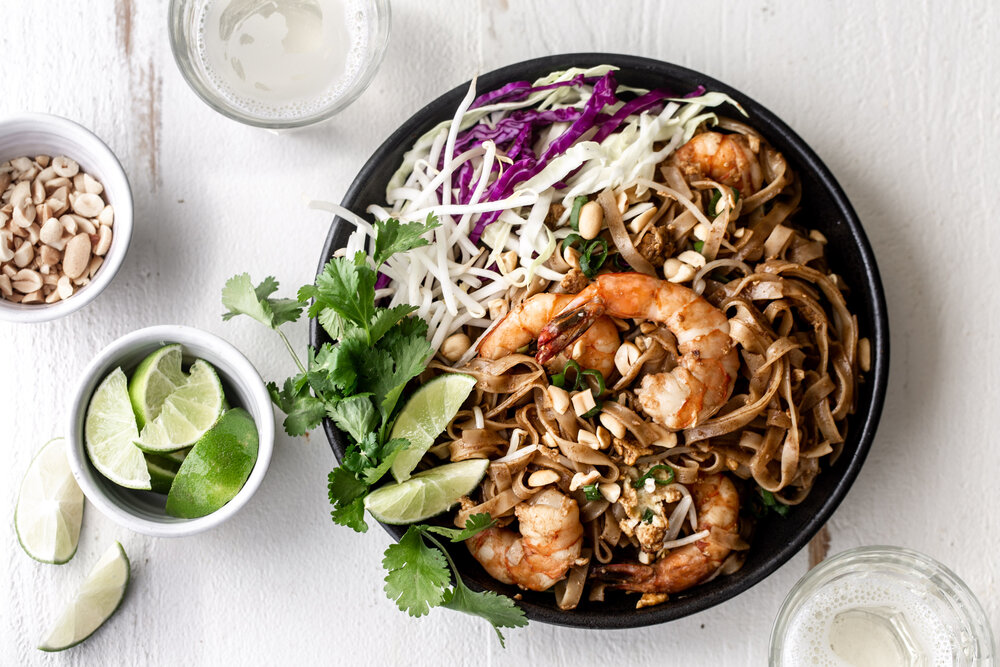
)
)
)
Recipes look great!
Delicious! Kylie never disappoints. Super easy and quick, and a dinner you can already have most ingredients at home. We did half the serving with shrimp, and will use chicken with the leftovers. 10/10!
I made this a couple weeks ago for dinner. It was my first time making pad thai. I was able to find tamarind paste at whole foods –the sauce was delicious and so flavorful. It was delicious and great for leftovers the next day!
so happy to hear you enjoyed the pad thai recipe! Since you already bought the tamarind paste, I’d recommend trying my crispy salmon with soy tamarind sauce recipe!
When I decided I wanted to attempt to make pad thai, I knew that I had to try Kylie’s recipe because hers are always the crowd pleasers. THIS WAS A HIT. We had it for dinner last night and my mom asked me to make it again so we could serve it for lunch today.
haha I LOVE hearing that!!! Thanks so much for sharing Kelsey!